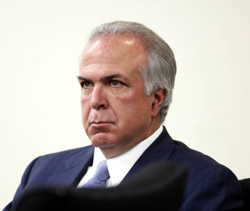Corasanti Due for Release in April
By Tony Farina
Dr. James Corasanti, acquitted last May of all felony charges in the death of 18-year-old skateboarder Alexandria Rice in July of 2011, is expected to be released from jail in mid-April after serving eight months of his one-year sentence on his misdemeanor DWI conviction that followed a sensational 13-day trial in Erie County Court.
According to Tom Burton, a member of Corasanti’s legal team, the doctor’s plans “are still up in the air,” although Burton says Corasanti, a gastroenterologist, has patients waiting for him and will be free to resume his medical career here or someplace else after his release from the Alden Correctional Facility.
“The misdemeanor conviction left him with many options that would not have been there if the prosecutors had proven the felonies,” said Burton. “He would have probably lost his license and obviously [would have] faced much different jail time.”
The jury, after hearing all of the testimony and weighing volumes of evidence in the heavily covered trial, found Corasanti not guilty of felony manslaughter, leaving the scene of an accident, and tampering with evidence, a verdict that drew a storm of public protest and prompted death threats against Corsanti’s three attorneys, Burton, Joel Daniels, and Cheryl Meyers Buth.
The Buffalo News called the trial and acquittal the top local story of 2012, saying “it riveted the region and outraged many community members who considered his verdict a travesty and an indictment of the criminal justice system.”
“The decision makers were the 12 people (jury) who heard all the proof,” said Burton in recalling the public outcry. “Many others tried the case in the media but it wasn’t the media that was going to be voting. We focused on the proof, kept our pronouncements to the minimum, and concentrated on the courtroom, not the front page.”
The government had charged that Corasanti was drunk from drinking at a golf outing on the night his car struck Alix Rice on Heim Road and that he kept on going after hitting the girl. The partying by a prominent physician, his expensive car, and his failure to stop after apparently hitting something on the dark road was the subject of story after story, and the coverage seemed to have already convicted him before the trial even started, at least in the mind of the public.
Burton said the defense faced three major challenges in preparing to go to trial:
1) Weed out potential pretrial bias with the jury.
2) Meet the onslaught of government resources throughout the case.
3) Focus in to show the jury what really happened with this tragedy, how the accident took place without 15 or 20 (government) investigators who had to do it after the fact.
“We had to refute the evidence the government put in,” said Burton.
“There were over 2000 photos, almost 500 acts of measurements, and thousands of pages of testimony and statements.”
Burton, himself a former cop and prosecutor, said the defense team “was able to bring some diverse skills to the fray and the biggest challenge was to get the whole picture of what happened to the jury and it was not consistent with the government’s prosecution theory.”
According to Burton, “the government had him (Corasanti) at about 52 mph and our expert, using the same info and measurements and photos, had him at 39.5 mph at impact. They said he hit her in the bike lane and our experts say the first event was in his lane, a difference of professional opinion.”
And Burton said prosecutors “could not exclude the fact that the skateboarder (Alix) was presenting a profile of less than 30 inches off the ground and that her silhouette was completely black, crouched down, all black, in his lane, in the darkest spot between two street lights. He didn’t realize he had struck a person.”
The defense lawyer also says it was never reported that police following the path of Corasanti’s car to his house over a mile away found that droplets from the impact area never weaved or went to the right of the fog light, evidence he said that is inconsistent with someone who is drunk.
Additionally, Burton says “blood” found on a rag at Corasanti’s house that that police claimed was used to wipe off the car “could have been dried blood from the bottom of the garbage can or spaghetti sauce. The tests they (police) used could give multiple false positives and the DNA tests came back negative.”
The post-trial analysis will do little to change the course of events, as a young girl is dead and will never return to her family and Corasanti’s life will certainly never be the same. But the defense was effective in creating reasonable doubt in the jury’s mind about what happened that tragic night and despite the overwhelming negative publicity, they acquitted the physician of the felony charges.
In recalling the coverage, Burton, the ex-cop, said he is still troubled by the fact that Corasanti’s trial seemed to overshadow everything else bad happening on Buffalo’s streets.
“There were multiple people shot (during the trial), some killed, in Buffalo and the attention to that barely made the obit page,” he said. “The hurt and trauma and loss to those inner city folks were no different than what happened in this (Corasanti) tragedy. It’s troubling when a defendant’s station in life is more important than some of these broader problems, like homicides in the city of Buffalo.
“We tried to do our jobs and we had police around our house. Some of the death threats were outrageous. Those cowardly, anonymous people couldn’t shine the shoes of the jury that did their job.”
James Corasanti did take the stand in his own defense and was aggressively grilled by lead prosecutor James Bargnesi. But the doctor apparently was able to help his own cause and build on his defense that he didn’t realize he had struck anyone that tragic night. With his release in a few months, he will have an opportunity to try and pick up his life. There will be no second chance for Alix Rice.
For the family of the young girl, life will never be the same. Her mother, Tammy Schueler, and her father, Richard Rice, are doing their best in various ways to keep her memory alive.
“Maybe it’ll make people think before they do the same thing,” said Tammy. “Maybe it will work, or it won’t, but I hope it does.”

